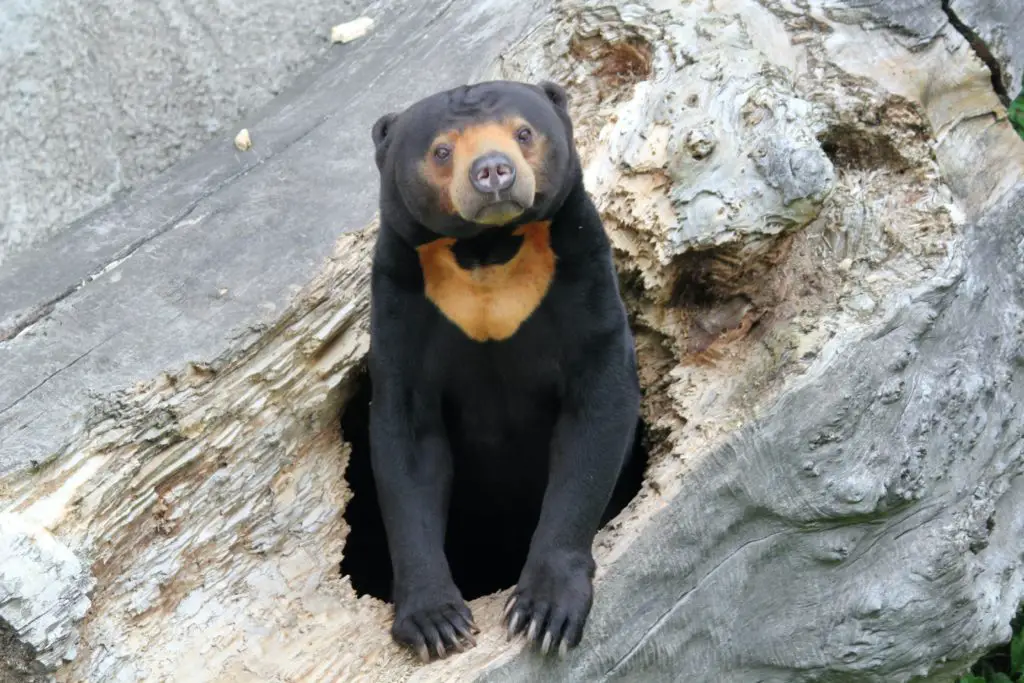A peculiar relative of the raccoon family (see procyonid), the kinkajou (Potos flavus), sometimes named honey bear, is characterized by its length, opposable tail, short nose, and reduced, round ears. The kinkajou is an acrobatic resident of the top canopies of tropical forests, native to Central and South America and parts of South America. The only species in the Potos genus is the kinkajou. Its look, behavior, and habitat are more similar to those of a monkey even though it is linked to the raccoon and coati. The kinkajou was originally a lemur to the science establishment. It features a simple, rounded face, silky gray or brown fur, and big eyes. The eyes have a strong orange eyeshine due to their highlight reflection. The bottoms of the kinkajou’s feet are thickly covered with short hair and they can be turned 180 degrees. Including its 40–57–cm (16–22 inch) tail, its overall length is lower than 61 cm (24 inches). Adults weigh between 2 and 3.2 kilograms. Let us know more detail about ‘How Much Does Kinkajou Cost?’.

How Much Does Kinkajou Cost?
Talking about the prices of Kinkajou, they fluctuate in price depending on many factors
So How much does Kinkajou cost?
- A baby kinkajou costs between $700 and $3,500, depending on the producer, brand, maturity, and sexual identity.
- Depending on a few ads we discovered on exoticanimalsforsale.net, the majority of costs varied between $400 and $3,000 in some cases.
- The kinkajou alone can cost around $2,000 according to this JuliesJungle.com care document, but costs are susceptible to alter without notification.
- There are 7 distinct varieties of kinkajous, therefore they can be different sizes. The largest types can grow to be 25 inches long and up to 18 lbs in weight. Once they are between 18 and 30 months old, they reach puberty, with the female coming into heat every 3 months. Each year, they may give rise to one to two babies.
- Its interior fur is often grey, and its short ears match its huge eyes. Its feet typically have five hooked toes on each foot and are short for tree climbing. In the environment, kinkajous can cling to nearby trees because of their opposable tails. Whenever an animal is ascending, it could use these completely prehensile gripping tails as an additional “hand.” Kinkajous utilize their tails, which serve as the fifth arm, and both nails on their feet to climb trees like monkeys. The tails, which may grow to be almost as long as the body, are also utilized for balance when jumping from one limb of a tree to the next.
- They typically survive in confinement for 20 to 25 years, however, they have been allowed to survive as long as 40 years.
What additional fees are there?
- Based on its size and structural components, a cage or environment with at least 20 square feet, a sturdy structure to protect their feet, and secure locking can cost a lot of money. If a gate has been created all around the prison, this should, at the very least, contain hidden wire at 90 degrees to prohibit their escaping. These prisons, when constructed, must resist any scaling and burrowing. Homeowners advise an aviary with a roof and a small inner space with access to natural sunlight. There should be ledges, racks, climbing ropes, and plastic bottles for lounging inside these enclosures.
- Fruits, veggies, and monkey cookies are all good foods for kinkajous. Grapes, graham crackers, or dates are examples of occasional treats. Depending on the type of meals eaten, be ready to pay a few pounds each day. Bananas, papayas, mangoes, melons, kiwis, grapes, pineapple, pomegranates, and figs are frequent foods that owners give their kinkajous.
- Costs for spaying and neutering might reach $200.
- Consider both routine and unscheduled appointments to the veterinarian, particularly while you’re younger. Annual vaccination against diseases like hepatitis, parvo, and canine distemper is required for kinkajous. They need regular deworming treatments. Their non-retractable claws need to be clipped, and according to your choice, you can either have the vet do it or, if you feel confident doing it yourself, you can do it yourself.
- Toys in the enclosure are recommended to keep animals engaged. This included shelving, ropes, and toys.
- To ever own a kinkajou, you may need specific permission in several states. The annual cost of these licenses can reach $200.
- If you purchase from a veterinarian online and you live outside, postage costs can be involved.
- They are quite sociable, according to JandaExotics.com. Budgeting for another to keep it company while you’re away doesn’t harm, even though it’s up to you.
In Conclusion
we can say that Kinkajou is considered a highly-priced animal because it is one of the rare brands in the world and its breeding costs a lot of money from all sides

